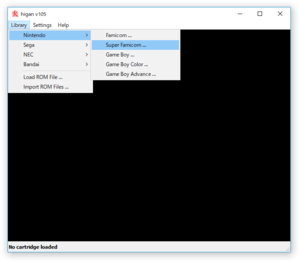higan (emulator)
|
| |
 higan v105 running on Windows 10 | |
| Developer(s) | byuu et al. |
|---|---|
| Initial release | October 14, 2004 |
| Stable release |
106
/ November 19, 2017 |
| Repository |
|
| Written in | C++14, C99 |
| Operating system | Windows, Linux, macOS, FreeBSD |
| Platform | Independent: IA-32, x86-64, ARM32/64, MIPS, etc. |
| Size |
|
| Type | Video game console emulator |
| License | GNU GPLv3 |
| Website |
byuu |
higan is an emulator for multiple video game consoles, including the Super Nintendo Entertainment System. Originally called bsnes,[1] the emulator is notable for attempting to emulate the original hardware as accurately as possible through low-level, cycle-accurate emulation and for the associated historical preservation efforts of the SNES platform.[2][3]
Supported systems besides the SNES include the Nintendo Entertainment System, Game Boy (Color), Game Boy Advance, Sega Master System and WonderSwan (Color). The newest and younger additions since version 103 are the Game Gear, Genesis (Mega Drive), TurboGrafx-16, and SuperGrafx cores.
Overview
Development of the emulator began with the name bsnes, written by a programmer known only by the pseudonym byuu on October 14, 2004. The first version was released in May 2005 for Microsoft Windows. Since then, it has been ported to Linux, macOS, and FreeBSD. Initially developed under a custom license, later releases were licensed under various versions of the GNU General Public License, although the main developer does sell GPL exceptions on a case-by-case basis to companies and individuals who want to base products on higan without the GPL's requirements, which helps fund further development.
The higan project has contributed significantly to the field of SNES emulation, with a number of original achievements in its emulation, and in reverse-engineering developments such as the organization of funds, hardware, and expertise for decapping the SNES's enhancement chips.[3]
higan is able to run every commercial SNES title ever released.[4] It is the first emulator to have featured SPC7110 emulation, cycle-accurate SPC 700 emulation, cycle-accurate Super FX emulation, Super Game Boy emulation[5], and a dot-based instead of scanline-based renderer for Game Boy Advance. It is the first multi-emulator of this breadth to achieve cycle-based emulation for every single component of every system.
Forked versions of bsnes have provided emulation support for Nintendo DS, XBAND, Super Famicom Box, Satellaview BS-X software, and tool-assisted speedruns.[6]
Reception
In 2008, British Internet magazine WebUser recommended bsnes for "some fun old-school gaming".[7] In 2009, Japanese game magazine GameLabo recommended it for "those seeking a realistic playing experience".[8]
In 2017, components of higan's source code were used to emulate the vintage text-to-speech computer utilized by physicist Stephen Hawking, after the original hardware began showing signs of wear. Hawking would continue using this emulator to converse with others until his death in 2018.[9]
See also
References
- ↑ "new name - higan". Archived from the original on April 14, 2013. Retrieved October 8, 2012.
- ↑ Byuu (August 9, 2011). "Accuracy takes power: one man's 3GHz quest to build a perfect SNES emulator". Ars Technica. Retrieved March 11, 2015.
- 1 2 Fenlon, Wesley. "16-bit Time Capsule: SNES Emulator Makes a Case for Software Preservation". Retrieved March 11, 2015.
- ↑ Bannister, Richard (February 2006). "Emulation Nation: Interview - Richard Bannister". Retro Gamer (Interview) (21). Interviewed by Craig Grannell. p. 97.
- ↑ "The State of Emulation, Part III". byuu's homepage. Archived from the original on April 14, 2013. Retrieved July 5, 2012.
- ↑ "tasvideos.org Preferred Emulators". tasvideos.org. Retrieved May 13, 2012.
Isnes
- ↑ "Downloaded". WebUser (191): 39. 2008.
- ↑ "SFC". GameLabo (September): ?. 2009.
- ↑ Jason Fagone (March 18, 2018). "The quest to save Stephen Hawking's voice". San Francisco Chronicle. Retrieved March 19, 2018.
External links
- Official website
- Linux packages for various distributions